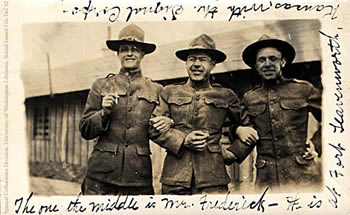
Lesson Nineteen:
Economic and Political Change between the Wars, 1919-1939
The Doughboys, (left). The text surrounding this photograph of three young servicemen (an image found in the University of Washington's IWW materials) reads: "The one in the middle is Mr. Frederick. He is at Fort Leavenworth, Kansas, with the Signal Corps." (Special Collections, University of Washington, Social Issues Files Dc/i)
An influenza pandemic (below) greeted servicemen in the United States following the Armistice ending the "Great War." This explains why the men off-loading the injured were wearing surgical masks. This view may have been taken at Fort Lewis in Pierce County, Washington. The base was one of the many Army facilities established during this war. (Special Collections, University of Washington)
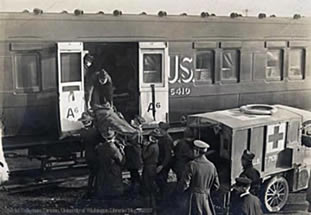
World War One marked an important turning point in both regional and national history. An political era of reform and radicalism came to an end. The outcome of the war brought disillusionment to the United States; people felt less confident of the progress about which reformers had been so confident, and they increasingly tolerated repression of those who had advocated more extensive political and social changes. Disillusionment can be a healthy thing if it strips away illusions about the world, and skepticism about progress can similarly make peoples less complacent. In the 1920s, in fact, Americans were more prepared to criticize mainstream values, and more inclined than before to find virtues in the cultures of peoples of colors—cultures that, in the case of Native Americans, they had before wanted to destroy or disparage. [On the resulting changes in Indian policy, see Lesson 12 and consult Sherry L. Smith, "Reimagining the Indian: Charles Erskine Scott Wood and Frank Linderman," Pacific Northwest Quarterly 87 (Summer 1996): 149-58, for a regional study of the new attitudes.] But while the 1920s was in some senses a more tolerant decade, it was a more conservative decade in many other regards—as events in the Pacific Northwest demonstrated.
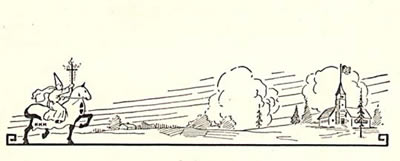
The Ku Klux Klan in Oregon, (left). (Reproduced in George Estes, The Old Cedar School. Troutdale, Oregon, 1922.)
Republicans dominated elections in Washington, Oregon, and Idaho during the 1920s. In Washington, they cut government expenditures dramatically. Governor Hartley made it a special point of his administration to fire Henry Suzzallo, the liberal president of the University of Washington, and create an agency to rein in the excesses and independence of higher education in general: "Call [the agency] what you wish, so long as it is given authority to say to the five institutions what they shall teach, what monies they shall expend, and what accounting they shall make." The University lost autonomy, had its budget cut, and entered a period of demoralization. In both Washington and Oregon, conservatism also appeared in the guise of nativism. The Ku Klux Klan and other proponents of "true Americanism" moved to defend institutions that they believed to be under attack by "outsiders," who included immigrants, Catholics, and Jews. In 1922 Oregonians passed an initiative, supported by the Klan, that required parents to send children to public schools; it was meant to abolish parochial schools and reduce the influence of the Roman Catholic church. (A similar initiative was defeated in Washington, which had a more diverse population.) The Oregon bill was declared unconstitutional and never implemented, but it did typify the power of nativist sentiment at the time. So did Washington's and Oregon's laws, passed in 1921 and 1923 respectively, forbidding Japanese immigrants from owning land. Moreover, Northwesterners lent support to the national efforts, culminating in the Immigration Act of 1917, the First Quota Act of 1921, and the Second Quota Act of 1924, to close the door on immigration, particularly from Asia.
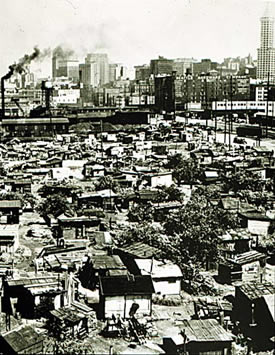
The Hooverville in Seattle, (right) shown here in 1937, was one of many such communities for the homeless created by unemployed workers during the Depression. (Special Collections, University of Washington)
While racism and ethnocentrism lay behind anti-immigrant sentiment, perceptions of immigrants as economic competitors made feelings stronger. And those worries were heightened by the economic malaise of the years after World War One. Indeed, key parts of the Northwest economy slumped, starting with the cutbacks in government contracts at the war's end and continuing throughout the 1920s. Mining and farming were hit especially hard by the downturn, and did not truly recover until the Second World War. The economic doldrums of the 1920s dramatized the enduring complaint of the region's boosters: the Pacific Northwest was too underdeveloped, especially in manufacturing, and thus it remained too much a colony of more developed regions of the country. One explanation for such economic conditions was the lack of population. In 1930 the four states of Oregon, Idaho, Washington, and Montana possessed 13% of the nation's land area but only 2.8% of its population. Related to underdevelopment and underpopulation were two other conditions—the region's lack of political power in Congress, and its relatively provincial culture. In economic, political, and cultural terms, the Pacific Northwest continued to play catch-up to the rest of the nation.
Beginning in 1929, the region's relationship to the rest of the nation began to change. A sequence of national crises—the Great Depression, World War Two, and the Cold War—transformed the Pacific Northwest in dramatic ways over the next six decades. By the 1940s and 1950s and 1960s, the region was playing a much more integral and less dependent role in the nation's economy, had attained significantly more political clout, and had begun to shed its reputation as a cultural backwater. One key to these changes was the growth of the role of the federal government in regional affairs. Beginning during the Great Depression and then continuing during World War Two and the Cold War, the United States played a powerful role in underwriting economic change in the region. It could be said that Washington, D.C., had replaced Wall Street as the economic "master" of the region. And in many localities, the heavy hand of federal agencies provoked resentment and suspicion. However, the federal government generally proved to be a more benevolent master, in part because the ability of the entire region (if not each locality) to influence the U.S. government increased during the same period. Northwesterners were increasingly able to enlist Uncle Sam as an ally in support of economic development. Thus the other states of the union helped to underwrite the expansion of the regional economy.
In historical perspective it is easy to say that the national crises of 1929-1989 helped to pull the Northwest out of its economic doldrums and accelerate its social and cultural development. However, it is important to keep in mind that the Great Depression, Second World War, and Cold War were crises during which Americans and Northwesterners experienced considerable hardship. Even in hindsight it makes no sense to call the Great Depression a blessing. The Northwest suffered more than most parts of the country from economic collapse. As the following chart illustrates, it lagged behind the rest of the nation in recovering from the drop in employment.
|
Two things about this chart deserve mention. First, note the uneven nature of recovery. Levels of employment bottomed out in 1933, rose through 1937, and then declined again. The economy was not emerging from depression on the eve of the Second World War. Second, Idaho was hit hardest of all, in large part because of its heavy reliance on the single extractive industry of mining. If the Pacific Northwest remained under-developed by comparison to the rest of the country, Idaho possessed the least developed economy among the three states. |
||||||||||||||||||||||||||||||||||||||||||
Conditions portrayed in this view were many of the reasons why farming families living in other parts of the country moved to the Pacific Northwest during the Depression years. This "dust bowl scene" (below) was photographed in Kansas in 1935. (Special Collections, University of Washington. Courtesy, Kansas State Historical Society, Topeka, KS)
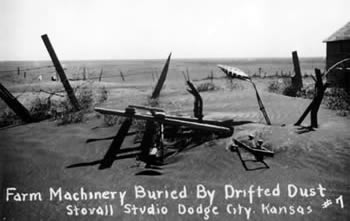
A few more figures can illustrate further the depths of depression in the region. By 1933, lumber exports stood at about half what they had been in 1929. Many agricultural products brought prices so low that they were not worth shipping to market; some apple and prune growers uprooted their trees and burned them for fuel. Mining output in Idaho dropped from $32 million in 1929 to $9 million in 1933. By 1933 income levels across the three states had declined to about 55% of what they had been four years earlier. Rates of tax delinquency and business failure, of course, had climbed greatly. The surest sign of an interruption in the normal course of things was that, for the first time since the 1840s, mainstream society was united in trying to discourage migration to the region from back east—for fear that newcomers would only add to already overburdened welfare rolls. In fact, the population of the area did not stop growing during the 1930s; it actually increased by about 10%, largely because so many people from the Midwest moved to the region seeking work. (For a fictionalized account of one North Dakota family's move to the Northwest, see the assigned short story by Lois Phillips Hudson, "Children of the Harvest," which is drawn from Hudson's personal experiences.)
The Pacific Northwest did not have nearly enough work to accommodate all the recent arrivals in the region. However, it did gain some new jobs (and a reputation for having abundant work) from the launching of the Columbia Basin Project, a massive, federally funded and directed effort to "tame" the Columbia and Snake rivers by building big dams that would generate hydroelectricity, facilitate irrigation of farms, and permit inland navigation by ocean-going vessels, among other things. This program represented one effort of the New Deal of President Franklin D. Roosevelt to help bring relief, recovery, and reform to the regional economy, and it was welcomed warmly in the region. (The assigned text by Wesley Arden Dick, "When Dams Weren't Damned," summarizes 1930s attitudes toward the Columbia Basin Project, which differ from our own.) The federally supported building of dams on the Columbia system marked a sea change in the political relationship between the Pacific Northwest and Washington, D.C. It also mirrored the transformation of party politics within the region.
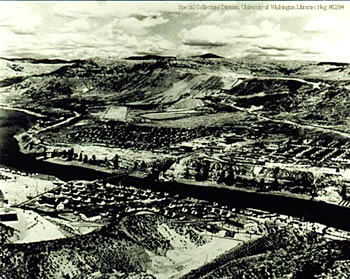 The Engineers' camp on the site of Grand Coulee Dam before construction began. (Special Collections, University of Washington, neg. #62594)
The Engineers' camp on the site of Grand Coulee Dam before construction began. (Special Collections, University of Washington, neg. #62594)
Prior to the Great Depression the Pacific Northwest had been heavily Republican. In 1928, only one county in the three states of Idaho, Oregon, and Washington had given a plurality of its votes to the Democratic candidate for president, Al Smith. The crash of 1929 changed all that. In 1932, only two counties in the three-state region remained loyal to the Republican President Herbert Hoover. All the others supported Franklin D. Roosevelt, the Democrat. FDR actively courted the region during his campaign of 1932 by supporting the building of dams on the Columbia and its tributaries. He spoke directly to the question of a colonial Northwest economy by suggesting that further development of the Columbia River system would not only create jobs but also produce cheap electricity, which in turn would attract manufacturing jobs and provide power for farms and homes. In other words, he proposed investing in a new infrastructure that would not only put thousands of unemployed men to work but also permit the region to overcome its dependence on such extractive industries as mining and logging. (Little effective attention was paid to the dams' impact on another extractive resource—salmon.)
The Columbia Basin Project became the centerpiece of the assorted New Deal programs applied by the Roosevelt administration to the Pacific Northwest. There were other notable efforts—Civilian Conservation Corps programs in parks and forests; wildlife protection; public housing; irrigation projects; and creation of Olympic National Park in 1938 (over the objections of Washington state officials and the timber industry). But the Columbia Basin Project loomed the largest. It brought about the most change, and it also represented the greatest opportunity for the federal government to influence the Pacific Northwest. Yet this outcome dashed the hopes of some in the Northwest who had expected that economic development would remain under the control of local and regional residents rather than federal officials.
For years different groups within Washington state had lobbied and schemed to build a large dam on the Columbia River system. Interests centered in Spokane had advocated a dam on the Pend Oreille River, near the Idaho border. They "lost out" to interests from north central Washington, around the towns of Wenatchee and Ephrata, who advocated a dam in the Big Bend country, closer to them, at the Grand Coulee. The Grand Coulee site won out in large part because the larger dam required at that locale would be able to create income, and help offset the cost of irrigation works, by generating hydroelectricity. When it was selected, boosters in north central Washington were convinced that their communities would reap the maximum benefit from the construction and operation of the dam. They assumed that proximity counted for everything, that the local individuals who had so boosted the dam would exert some control over it in the end, and thus be assured of receiving their rightful share of benefits. (See also: "Rufus Woods, Wenatchee, and the Columbia Basin Reclamation Vision," by Robert E. Ficken, Pacific Northwest Quarterly). Their assumptions were proven wrong.
Large dams on the Columbia River—like transcontinental railroads—were deemed essential to the development of the Pacific Northwest, but the towns and states and businesses of the region lacked the resources to build them for themselves. They had to turn to outsiders to get the job done. In the case of the railroads, that had meant letting big corporations with headquarters back East have a disproportionate say in the economy and politics of the region. In the case of the dams, that meant letting the federal agencies that had provided the money run the Columbia Basin Project and make the crucial decisions about operation of the dams. Those decisions often contradicted the wishes of local interests, yet they ensured that the region as a whole would benefit enormously from the dams. For example, electricity would be provided as cheaply to industries and cities across the entire region as it would be to the farmers and townspeople living nearer the dam. Consequently, by the outbreak of World War Two the Pacific Northwest possessed a new infrastructure that permitted it to mobilize for war to an extent that would have proven impossible ten years before. Aluminum factories in Spokane and the Portland area, plutonium plants at Hanford, and aircraft manufacturing at Seattle all drew upon power from the Columbia Basin during World War Two. The economy of the Pacific Northwest reached new heights, and the region enjoyed unprecedented levels of prosperity. Wenatchee and Ephrata benefited some from this economic upswing, but they saw most of the industrial growth of the region pass them by. Power and wealth remained centered elsewhere—in Portland and Seattle and Washington, D.C.
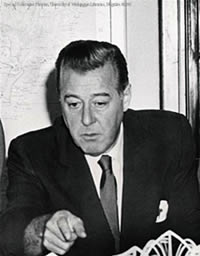 Since the 1850s the Pacific Northwest had slowly been urbanizing and industrializing. In other words, it had steadily become more integrated into national systems of communication, production, transportation, and cities. By the time the Columbia Basin Project got under way, it was no longer so remote, and at the same time it could no longer aspire to be so autonomous. The linkages to distant places that facilitated regional growth—railroad lines, massive dams—came with strings attached. Federal funding for and control over the Columbia Basin Project ensured that the U.S. government would play an enlarged role in the development of the region. Uncle Sam could hardly ignore the wishes of people who resided in the region, but he always had a variety of constituencies to please—some within the Northwest and some without. And this characteristic of regional history would only become more pronounced as the 20th century moved on. World War Two, the Cold War, and a series of social and environmental issues (e.g. questions of civil rights for minorities, and concerns over protection for wilderness and endangered species) would merely serve to elevate further the role played by the federal government in the Pacific Northwest.
Since the 1850s the Pacific Northwest had slowly been urbanizing and industrializing. In other words, it had steadily become more integrated into national systems of communication, production, transportation, and cities. By the time the Columbia Basin Project got under way, it was no longer so remote, and at the same time it could no longer aspire to be so autonomous. The linkages to distant places that facilitated regional growth—railroad lines, massive dams—came with strings attached. Federal funding for and control over the Columbia Basin Project ensured that the U.S. government would play an enlarged role in the development of the region. Uncle Sam could hardly ignore the wishes of people who resided in the region, but he always had a variety of constituencies to please—some within the Northwest and some without. And this characteristic of regional history would only become more pronounced as the 20th century moved on. World War Two, the Cold War, and a series of social and environmental issues (e.g. questions of civil rights for minorities, and concerns over protection for wilderness and endangered species) would merely serve to elevate further the role played by the federal government in the Pacific Northwest.
Senator Warren Magnuson's (right) political savvy was a major factor in the development of the Columbia basin water projects. Grand Coulee Power Station (below). At its completion, Grand Coulee Dam was publicized by the Bureau of Reclamation as "The World's Largest Power Plant." Almost half of the hydro-electric power of the Pacific Northwest was generated and distributed here through a massive system of substations. To advertise the benefits of public- versus private-power distribution, the federal government hired Woody Guthrie to write and perform folk songs advocating the blessings of public power. "Roll On Columbia" was one of his most well-known songs. (Special Collections, University of Washington, Portrait Files, neg. #2396)
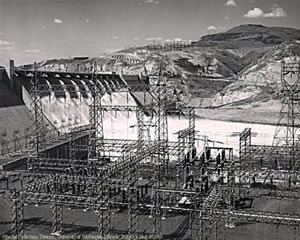
There was a pronounced difference, however, between how the U.S. government and a private corporation would conduct affairs in the region. The corporation had to answer to stockholders, while the government had to answer to voters. Many of those voters resided in the Pacific Northwest, and over the course of the 20th century they became quite effective at exerting influence upon Uncle Sam. In the period after 1930, in fact, voters in the state of Washington proved particularly effective at lobbying the federal government on behalf of regional and state and local interests. Their elected officials, and particularly the Democratic congressmen and senators Henry M. Jackson and Warren G. Magnuson, became particularly well-known for directing federal expenditures to their home state. [Walter Mondale of Minnesota, who served in the Senate alongside "Maggie," once described Magnuson's formula "for evenly dividing the federal budget among the states: 'Fifty percent for Washington state, and fifty percent for the rest of the country" (quoted in Magnuson's obituary, Seattle Post-Intelligencer, May 21, 1989).] With well-placed politicians such as Magnuson and Jackson—both of whom attained considerable seniority in the U.S. Senate—the Northwest enjoyed some ability to get the federal government to do its bidding.
One set of reasons for why the Evergreen State attained so much clout in the nation's capital also had its roots in the decade of the 1930s. Washington and Oregon had agreed for years on the need for dams to generate hydroelectric power; both agreed on the need for federal money to subsidize dam-building; both agreed that dams should produce cheap power. But they diverged on the question of who ought to benefit most directly from the kilowatts produced by the new dams. "Public power" interests (farmers, labor, and reformers) urged that the cheaper hydroelectricity be delivered as directly as possible to consumers, while their opponents (private utility companies, urban businessmen, and manufacturing interests) favored the power being used primarily for industrial purposes. In the state of Washington, the Democratic Party used the issue of "public power" to take advantage of the opportunities presented by the Depression and the Columbia Basin Project, and redeveloped itself into the more forceful party in the state. Democrats in Oregon, by contrast, were much less effective at using the issues of the 1930s to revitalize their party, and Oregon—like many western states—reverted fairly quickly to the predominantly Republican politics of the pre-1929 era. [See Paul Kleppner, "Politics Without Parties:The Western States, 1900-1984," in The Twentieth-Century West: Historical Interpretations, ed. Gerald D. Nash and Richard W. Etulain (Albuquerque: University of New Mexico Press, 1989), 317-24. Let me add that Oregon's Republican politicians in the 20th century seldom fit the national Republican mold. But the key point is that, because of differences in party alignment between the two states during and after the 1930s, Oregon lacked the clout in the nation's capital that Washington possessed.]
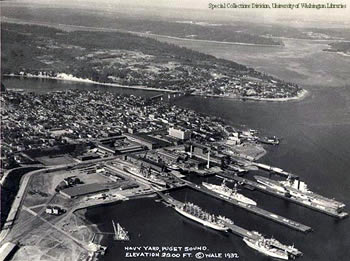
The way that the Democratic Party in Washington seized upon the issue of "public power" in the 1930s helps to explain how Democrats like Jackson and Magnuson (and Tom Foley and Norm Dicks) kept getting elected. These individuals attained seniority in the party that dominated Congress between 1932 and 1994. As a result, they stood in a very strong position to see that the interests of Washington would be well served by the U.S. government in the middle and later decades of the 20th century. The Evergreen State was by no means the complete master of its own destiny; a wide variety of forces continued to impinge upon the state's autonomy, so that not even Magnuson or Jackson could insulate it from the rest of the world. But Washington arguably had less reason to fear Uncle Sam that did many other states. Its relationship to the federal government had been changed dramatically by the events of the 1930s. And the region, too, had begun to change in profound ways. Then the Second World War accelerated those changes.
Bremerton Naval Shipyard (right): World War II in the Puget Sound region began in 1940, when President Roosevelt issued an order to place in readiness all military bases in the country. The Puget Sound Naval Shipyard, shown here in 1932, was one of the first to benefit from the order. Following the Pearl Harbor attack on Dec. 7, 1941, the damaged Pacific fleet destroyers were returned to this Bremerton facility for repair and modernization. (Special Collections, University of Washington. Photo by Ware, copyright 1932.)
| Course Home | Previous Lesson | Next Lesson |